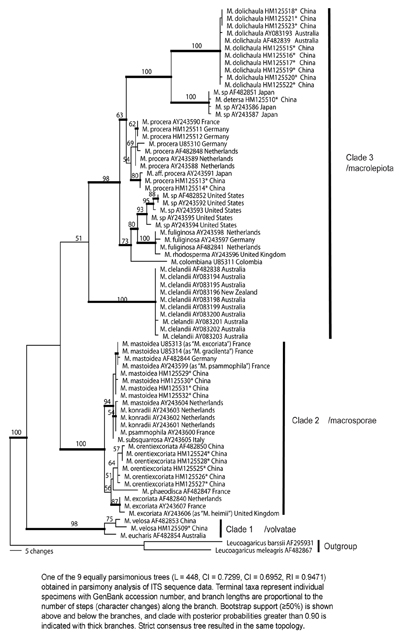Lepiotaceous fungi are in general saprotrophic forest floor dwellers. Some of them are excellent edible fungi while quite a few are poisonous. As this group of fungi act a key role in the evolution of basidiomycetes, they have long been the research interests for many mycologists.
Under the financial support from National Natural Science Foundation of China (grants no. 30800004) and the Joint Funds of the National Natural Science Foundation of China and Yunnan Provincial Government (Grant No. U0836604), species diversity and molecular phylogeny of Macrolepiota, as well as its allied genera, i.e. Leucoagaricus, Leucocoprinus, and Sericeomyces, were critically investigated, and several valuable results were acquired.
Firstly, species of the genus Macrolepiota (Agaricaceae) in China were investigated on the basis of morphology and DNA sequences data. Six species, i.e., M. detersa, M. dolichaula, M. mastoidea, M. orientiexcoriata, M. procera, and M. velosa are recognized, of which M. detersa and M. orientiexcoriata are new. All of them are described and illustrated with line drawings, and a key is provided to the recognized species. ITS sequences were used to support the new species delimitations and to test the conspecificity between the Chinese specimens and their relatives from other continents. Phylogenetic analyses identify three clades within Macrolepiota: /macrolepiota, /macrosporae, and /volvatae clade. The former two clades respectively correspond to the available sections (sect. Macrolepiota and section Macrosporae) in Bon’s infra generic classification. Section Volvatae is proposed to accommodate species with a volva within Macrolepiota (Ge et al. 2010. Fungal Diversity 45: 81-98).
Secondly, Current classifications of the tribe Leucocoprineae were evaluated using analyses of sequence data from the nuclear ribosomal large subunit gene (nLSU), the internal transcribed spacer region of the nuclear ribosomal array (ITS), and the mitochondrial ribosomal small subunit gene (mtSSU). Results of the parsimony and Bayesian analyses showed that neither Leucoagaricus nor Leucocoprinus is monophyletic group with species of either genus shifted from one to another. The species diversity study of Leucoagaricus in China resulted in several new findings. Among the identified species, three new species, i.e. Leucoagaricus orientiflavus, Leucoagaricus flavovirens, and Leucoagaricus atroazureus are officially published, and two new combinations, namely Leucoagaricus caerulescens and Leucoagaricus viriditinctus are proposed (Ge 2010. Mycotaxon 111: 121-126;Liang et al. 2010. Mycologia 102: 1141–1152).







